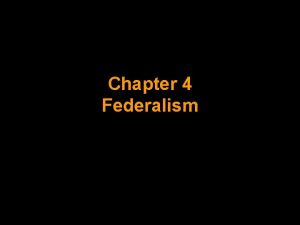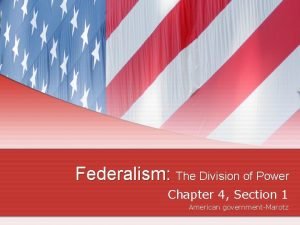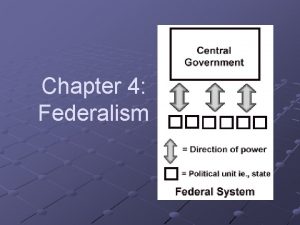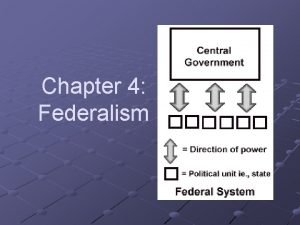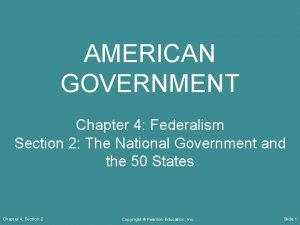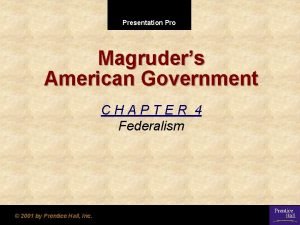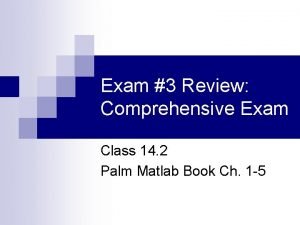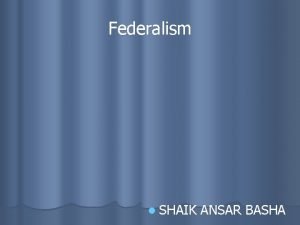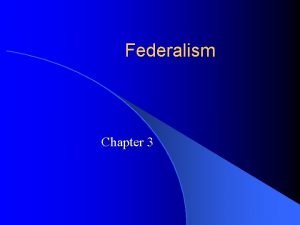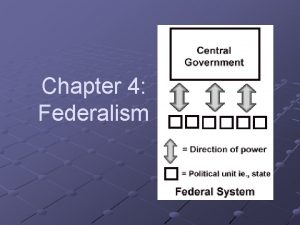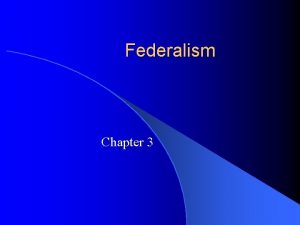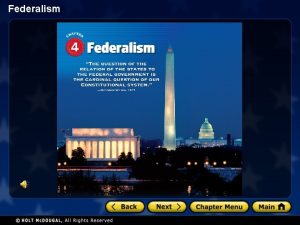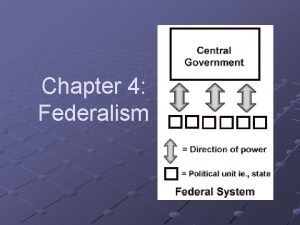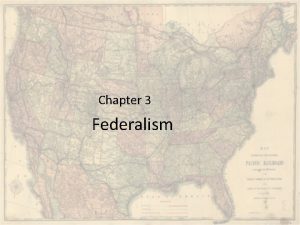Chapter 3 Federalism To Accompany Comprehensive Alternate and
















- Slides: 16

Chapter 3 Federalism To Accompany Comprehensive, Alternate, and Texas Editions American Government: Roots and Reform, 10 th edition Karen O’Connor and Larry J. Sabato Pearson Education, 2009

The Roots of the Federal System Under the Articles, U. S. was a confederation. Could not be unitary system like Great Britain. Chose a federal system. National and state governments share power. National and state governments get power from people.

National Powers Enumerated powers set out in Article 1, Section 8. Include coining money, providing army, creating courts. Necessary and proper clause is basis of implied powers. Article VI includes supremacy clause.

Other Powers Tenth Amendment deals with powers not enumerated. Reserves rights for states or the people. Includes regulation for health, safety, and morals. Other powers are concurrent, or shared. Include taxation, making laws, chartering banks. Other powers are expressly denied. Include bills of attainder and ex post facto laws.

Relations Among the States must give full faith and credit to other states. Privileges and immunities clause guarantees equality. States are required to extradite criminals. States work together through interstate compacts.

The Marshall Court Helps to define balance of state-federal power. Mc. Culloch v. Maryland (1819). Concerns states’ power to tax the national government. Gibbons v. Ogden (1824). Concerns Congress’ power to regulate commerce.

Dual Federalism, 1800 -1932 Defined by two separate governments. Each has its own sphere of responsibility. Characterized as layer-cake federalism. Dred Scott rules that Congress cannot regulate slavery. Federal government grows and changes after Civil War. Sixteenth and Seventeenth Amendments set stage.

Cooperative Federalism, 1932 -80 Cooperative federalism defined by collaboration. Characterized as marble-cake federalism. Result of New Deal recovery efforts, 1930 s. Also seen in Great Society program, 1960 s. Use of categorical grants.

New Federalism, 1980 -2001 New Federalism defined by return to state power. President Ronald Reagan was a pioneer. Use of less restrictive block grants. Also seen in 1990 s Republican Revolution. Passage of law attempting to end unfunded mandates. President George W. Bush departs from this trend. Prompted by 9/11 and the use of preemption.

Supreme Court and Federalism Court has played significant role in defining federalism. Idea of “new judicial federalism. ” Issue areas such as sovereign immunity and abortion. Rehnquist Court initially seemed pro-states. More recent decisions were mixed. Uncertainty exists about direction of Roberts Court.

AV- Access to Abortion Back

Figure 3. 1 - Governments in the U. S. Back

Figure 3. 2 - Systems of Government Back

Figure 3. 3 - Distribution of Power Back

Figure 3. 4 - Supreme Court and Federalism Back

Table 3. 1 - Compacts by the Numbers Back
 Accompany chapter 1
Accompany chapter 1 Things that belong to salvation
Things that belong to salvation Iv bubble trap
Iv bubble trap Inkjet printers are considered legacy technology
Inkjet printers are considered legacy technology Federalism powers divided worksheet
Federalism powers divided worksheet Chapter 4 section 1 federalism the division of power
Chapter 4 section 1 federalism the division of power Chapter 4 federalism the division of power
Chapter 4 federalism the division of power Chapter 4 federalism
Chapter 4 federalism Chapter 4 federalism
Chapter 4 federalism Chapter 4 federalism answer key
Chapter 4 federalism answer key Chapter 4 federalism
Chapter 4 federalism Difference between regionalism and federalism in a sentence
Difference between regionalism and federalism in a sentence Chapter 3 comprehensive exam
Chapter 3 comprehensive exam Two types of federalism
Two types of federalism Nationalist position definition
Nationalist position definition Federalists and anti-federalists
Federalists and anti-federalists Federalism
Federalism





